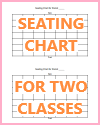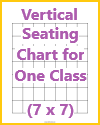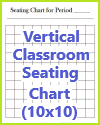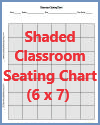| Free Printable Classroom Seating Charts |
|---|
| www.studenthandouts.com ↣ Classroom Organization ↣ Seating Charts |
| Get your classroom organized with our free printable seating charts. Don't forget to always leave one available for a substitute teacher. Always write in pencil, because seating arrangements change often (especially at the start of the school year). If you are looking for materials for your sub folder, click here. |
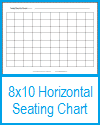 | 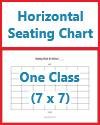 | 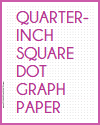 | ||||||||
| Horizontal Classroom Seating Chart (10 x 8) | Horizontal Seating Chart for One Class (7 x 7) | Quarter-inch Square Dot Graph Paper |
|
Classroom seating charts are helpful tools for teachers for several important reasons.
Classroom Management: Seating charts allow teachers to strategically place students in the classroom to facilitate effective classroom management. Teachers can assign seats purposely to minimize distractions, ensure equal access to instruction, and maintain a positive classroom environment. Behavior Management: Teachers can use seating charts to address behavioral issues by strategically placing students who may benefit from proximity to the teacher or away from potential distractions. This can help reduce disruptions and maintain a focused learning atmosphere.  Accommodating Special Needs: Seating charts enable teachers to accommodate students with special needs or individualized education plans (IEPs). For example, a student with hearing impairments may be seated closer to the front of the class to improve their access to instruction.
Accommodating Special Needs: Seating charts enable teachers to accommodate students with special needs or individualized education plans (IEPs). For example, a student with hearing impairments may be seated closer to the front of the class to improve their access to instruction.
Pairing or Grouping Students: Teachers can use seating charts to create effective student pairs or small groups for collaborative activities, discussions, or projects. This allows teachers to control group dynamics and ensure diverse participation. Learning Styles: Seating charts can be used to consider students' learning styles and preferences. For instance, visual learners might benefit from sitting closer to visual aids, while kinesthetic learners may prefer seats with more space for movement. Individualized Support: Teachers can use seating charts to provide targeted support to students who need it. For instance, struggling students can be seated closer to the teacher, making it easier for the teacher to offer assistance when needed. Attendance and Accountability: Seating charts help teachers take attendance quickly and accurately. By matching names with assigned seats, teachers can ensure that all students are accounted for at the start of each class. Emergency Preparedness: In case of emergencies or drills, seating charts can be crucial for accounting for all students and ensuring their safety. Teachers can quickly identify which students are present and which may need assistance in an evacuation. Personalized Attention: Teachers can get to know their students better by using seating charts. This can help in addressing individual needs, preferences, and concerns, fostering a stronger teacher-student relationship. Cultural Sensitivity: Seating charts can be used to promote cultural sensitivity and inclusion. Teachers can ensure that students from different backgrounds and cultures are seated in a way that respects their comfort and cultural preferences. Effective communication: Seating charts can help with classroom communication. Teachers can call on students by name more easily, fostering a sense of belonging and participation among students. Classroom Logistics: Seating charts can assist with logistical aspects of teaching, such as distributing assignments, managing materials, and organizing classroom activities efficiently. Parent-Teacher Conferences: When meeting with parents or guardians during conferences, teachers can use seating charts to point out where a student typically sits, making it easier to discuss the student's behavior or progress. Classroom seating charts are valuable tools that assist teachers in maintaining order, addressing individual needs, fostering a positive learning environment, and effectively managing their classrooms. They contribute to a more organized and productive teaching and learning experience. |
| www.studenthandouts.com ↣ Classroom Organization ↣ Seating Charts |


